35% of the Middle Class, 19% of all adults

Life is good for these middle class Americans—and most in this group predict it’s only going to get better. A 54% majority say their lives have improved in the past five years, and nearly half report they’re close to living their ideal life right now.
These Top of the Classers are the best educated of the four groups. They’ve got the highest incomes. And according to their own reports, they’re in the best of health of the four middle class groups. They also are the largest of the four classes: 35% of all adults who identify as middle class fall into the Top of the Class, or 19% of all Americans.
Who They Are
Fully four-in-ten are college graduates (41%) and another 29% attended college. Nearly a third (32%) have family incomes of at least $100,000 a year and almost two-thirds earn $75,000 or more. Virtually every member of this group earns at least $50,000 a year. In pointed contrast, no member of the Struggling Middle earns that much.
They exhibit other trappings of prosperity. Three-in-four (75%) own stocks, bonds or mutual funds, the most of any group. Fully a third (33%) receives income from interest on savings or bonds. And they have taken steps to secure their financial futures: Nearly nine-in-ten (86%) has an IRA, 401k or similar kind of retirement account, again tops of the four groups.
It’s no surprise, then, that members of the Top of the Class are the most likely of any of the four groups to say they are living “comfortably” (58% vs. 39% of the middle class as a whole) and the least likely to report they just meet their expenses or fall short each month.
Doctors, lawyers and other professionals are most likely to be found in this group. Whatever they do, many love their jobs: more than a third (36%) say they’re “completely satisfied” with their job while virtually all (96%) say they’re at least mostly satisfied.

In addition to being relatively wealthy and college educated, a plurality of these self-described middle-class Americans also enjoy good health: Fully 43% their overall fitness as “excellent,” compared with 31% of all middle class adults, the highest of any group. Only 6% say they feel “only fair” or “poor.”
When asked to compare their own lives to the lives their parents led at a similar age, more than seven-in-ten say they’re doing better than mom or dad, and nearly half say they’re doing “much better.” And when asked to rate their current lives on a scale ranging from 10 for the best possible life and zero for the worst, nearly half (46%) of this group rate themselves at or near the top of the ladder (ranking themselves as a ten, nine or eight) while only 12% place themselves on one of the lower rungs (5 or lower). They’re also the most optimistic about the future: 71% predict they’ll be at or near the top of the ladder in five years—that’s 25 percentage points more than say they’re currently at or near the top.

What They Think
These middle class Americans feel firmly in control of their lives and reject the view that fate rules their destiny; fully three-quarters disagree that success in life is beyond one’s control, the largest proportion of any of the four groups.
While a majority agrees with the proposition that “the rich just get richer and the poor get poorer,” a substantial minority of 35% disagrees, a figure matched within the middle class only by one other group — the Satisfied Middle.
Politically, the Top of the Classers are no more likely than the middle class as a whole to describe their views as politically conservative or liberal, or to disproportionately identify with one or another political party.
On a number of issues tested, however, they take conservative positions. They’re the only group in which fewer than half (45%) agree that the government has a responsibility to take care of those who cannot take care of themselves.

They also are the least likely to agree that the government should guarantee health care to every individual (62% vs. 72% for the middle class as a whole).
But on other issues they take moderate or liberal positions. For example, eight-in-ten (80%) disagree that women should return to their traditional roles in society, compared with 73% of all the middle class. And they’re no more or less likely than other groups to endorse gay marriage.
Whatever their political inclinations, they’re voters: fully 85% report that they are “absolutely certain” that they’re registered to vote, compared to 73% of all middle class Americans.




